The Lotus F1 Team unveiled its 2012 F1 car early this morning. It’s called the E20 and, as you can see, it features the “alligator” style nose we’ve seen already on the Caterham, Ferrari and Force India. We’re not sure if it’s because we’re now getting used to these noses, but the E20’s design doesn’t look too bad.
Of course, 2012 marks a new era for the Lotus F1 Team, which can trace its roots way back Toleman, the team which gave Ayrton Senna his F1 debut. There’s a new name and two new drivers, Kimi Raikonnen and Romain Grosjean. Technical Director, James Allison said: “Romain put in two very promising sessions at the end of last season, having not driven an F1 can for more than a year. He jumped in the car and was immediately competitive with our race drivers at the time, in a quite impressive fashion. I think that has gone a long way to getting him the ride for this year. So we’re looking forward to a strong start with him. Kimi’s recent test in Valencia with the R30 showed that he has lost none of his speed and that he is full of appetite for the season ahead. It is going to be great for us to work with a driver of such clear quality.”
Speaking about his hopes for the E20, Allison is keeping his cards close to his chest. “We’ve worked hard and long on the car. We have tried to react to the regulatory picture as it’s unfolded, but we will only really start to be able to judge how well we have done once we start to run the car in pre-season. Even then we won’t really know until qualifying in Melbourne,” he said.
There’s more pics and detail from Lotus after the break. Towards the end of the material you can also download the team’s 2012 press pack, which is loaded with information, some useful, some not so! You can even relive the launch thanks to a 20 minute video hosted by Jonny Smith from Fifth Gear.
Lotus F1 Team unveils E20 and sets championship targets
Press Release | 05/02/2012
Lotus F1 Team today unveiled its 2012 FIA Formula 1 World Championship challenger, the E20, on its website www.lotusf1team.com at 17:00 CET. Continuing with the evocative black and gold livery, the E20 heralds a new nomenclature to commemorate the twentieth chassis designed at the team’s Enstone base through its Benetton, Renault F1 Team and Lotus Renault GP history.
E20 – new name, new concept
The E20 incorporates ground–up redesigns and optimization of previous Enstone design philosophies. Most notably, the forward facing exhausts of 2011’s R31 have been abandoned, both through regulation and necessity. The E20 also features a ‘step’ on its nose, this layout also being the result of a regulation change.
The front and rear suspension layouts have been substantially revised in the quest for ever- better aerodynamic efficiency whilst the front wing is a continuation of concepts used by the team during recent seasons.
The E20 has been designed utilizing the team’s new 60% scale wind tunnel as well as its enhanced CFD facility, with both resources located on site at Enstone.
Clear Progress
Rexona and CLEAR, two of the world’s biggest personal care brands, are the latest partners to join the Lotus F1 Team. The brands, part of the Unilever portfolio, represent a perfect fit with the high levels of competition and performance associated with Formula 1 as a sport and more specifically with the Lotus F1 Team.
A proud history
This season will see the 500th Grand Prix contested by Lotus F1 Team, including those contested through its previous incarnations of Toleman, Benetton, Renault F1 Team and Lotus Renault GP.
Toleman Motorsport entered Formula 1 in 1981 and started 57 Grands Prix, until in 1986 the team was renamed as Benetton. In this guise 260 races were contested, until in 2002 the team became Renault F1 Team. As Renault F1 Team, 159 Grands Prix were started, with the team becoming Lotus Renault GP for 2011, contesting a further 19 events. The current total of Grands Prix stands at 495.
Driving forwards
Kimi Räikkönen, Romain Grosjean and Jérôme D’Ambrosio comprise a strong driver line-up which includes a world champion in Kimi, and two success-hungry hungry young guns in Romain and Jérôme. Kimi returns to Formula 1 eager to put the talents which have won him 18 Grands Prix and a World Championship to good effect in black and gold.
Lotus F1 Team E20 Technical Specifications
Chassis
Moulded carbon fibre and aluminium honeycomb composite monocoque, manufactured by Lotus F1 Team and designed for maximum strength with minimum weight. RS27-2012 V8 engine installed as a fully-stressed member.
Front suspension
Carbon fibre top and bottom wishbones operate an inboard rocker via a pushrod system. This is connected to a torsion bar and damper units which are mounted inside the front of the monocoque. Aluminium uprights and OZ machined magnesium wheels.
Rear suspension
Carbon fibre top and bottom wishbones with pull rod operated torsion springs and transverse-mounted damper units mounted in the top of the gearbox casing. Aluminium uprights and OZ machined magnesium wheels.
Transmission
Seven-speed semi-automatic titanium gearbox with reverse gear. “Quickshift†system in operation to maximise speed of gearshifts.
Fuel system
Kevlar-reinforced rubber fuel cell by ATL.
Cooling system
Separate oil and water radiators located in the car’s sidepods and cooled using airflow from the car’s forward motion.
Electrical
MES-Microsoft Standard Electronic Control Unit.
Braking system
Carbon discs and pads. Calipers by AP Racing.
Master cylinders by AP racing and Brembo.
Cockpit
Removable driver’s seat made of anatomically formed carbon composite, with six-point or eight-point harness seat belt by OMP Racing. Steering wheel integrates gear change, clutch paddles, and rear wing adjuster.
KERS
Motor generator unit driving into front of engine with batteries as an energy store. Motor Generator supplied by Renault Sport F1. Electronic control unit by Magneti-Marelli.
DIMENSIONS AND WEIGHT
Front track: 1450 mm
Rear track: 1400 mm
Overall length: 5038 mm
Overall height: 950 mm
Overall width: 1800 mm
Overall weight: 640 kg, with driver, cameras and ballast
RS27-2012 Engine Technical Specifications
Configuration: 2.4l V8
No of cylinders: 8
No of valves: 32
Displacement: 2400 cc
Weight: 95 kg
V angle: 90°
RPM: 18,000
Fuel: Total
Oil: Total
Power output: 750 bhp
Spark plugs: Semi surface discharge
Ignition system: High energy inductive
Pistons: Aluminium alloy
Engine block: Aluminium alloy
Crankshaft: Nitrided alloy steel with tungsten alloy counterweights
Connecting rods: Titanium alloy
Throttle system: 8 butterflies
E20: Technical Overview
James Allison: Formula 1 2012 Specification
Lotus F1 Team Technical Director James Allison looks to the season ahead…
How different is 2012 likely to be from 2011?
If you casually flicked through the regulations you’d be forgiven for thinking that there aren’t many differences from last year, however nestling in there are some fairly profound changes. The most notable changes relate to the exhaust. The teams decided around Silverstone in 2011 that we were going to get rid of exhaust blown rear diffusers, and that point alone requires a very different design concept. Recent car designs have been heavily influenced by their rear exhaust configurations, and the intent of the rule is to stop that happening. The rules on the exhaust geometries themselves have been reinforced by some engine operation rules which don’t sit in the technical regulations, but which arrived by Technical Directive quite late last year. The exhaust issue, although agreed in principle at Silverstone, continued to unfold as late as mid-November, so the challenge has been to roll with the punches as the detail emerged over a fairly extended period – trying to make the best of each version of the rules as they’ve come out, whilst trying to anticipate where the end position is going to be. It’s certainly been an area which has preoccupied us and I imagine the rest of the grid too.
How much will the new regulations affect what we see on track?
Last year’s cars had quite a variety of exhaust layouts, with differing levels of success. If the latest rules really have been successful in resetting the power of the exhausts to a much lower level, then that’s an opportunity for a reshuffle of the pack.
What are your feelings on working with two new drivers for 2012?
Romain put in two very promising sessions at the end of last season, having not driven an F1 can for more than a year. He jumped in the car and was immediately competitive with our race drivers at the time, in a quite impressive fashion. I think that has gone a long way to getting him the ride for this year. So we’re looking forward to a strong start with him. Kimi’s recent test in Valencia with the R30 showed that he has lost none of his speed and that he is full of appetite for the season ahead. It is going to be great for us to work with a driver of such clear quality.
What is completely new and what is more familiar on the E20?
Depending on where you look, some parts of the new car are a ground-up redesign and in other areas we have further optimised the best bits of the design philosophy we’ve adopted for several seasons. As far as the exhausts are concerned, our forward exhausts would now be illegal under the new rules and didn’t live up to our expectations in any case. So that part of the car we say goodbye to and welcome in a complete re-design. The front and rear suspension layouts are substantially revised to try and give us better aerodynamic opportunities. The front wing is a continuation of the concepts we have worked on since the 2009 rules were published. The rear wing system, we’ve continued to try to work on having a satisfactory level of rear downforce stability, whilst having a maximum DRS switching potential.
How much help is the team’s enhanced 60% wind tunnel for developing the E20?
The 60% wind tunnel has allowed us to expand dramatically the realism of the tests that we perform in our wind tunnel, so we get the car to more realistic steer and yaw values. Those are pretty fundamental things. That hopefully means that the car will be more tolerant of a wider range of cornering conditions.
How do you expect the E20 to perform?
We’ve worked hard and long on the car. We have tried to react to the regulatory picture as it’s unfolded, but we will only really start to be able to judge how well we have done once we start to run the car in pre-season. Even then we won’t really know until qualifying in Melbourne.
The testing schedule is rather different this year – nothing till February, then three tests followed by an in-season test at Mugello – does this make a difference?
The testing schedule with Mugello later on for this year gives us a fairly clear target mid-season. If there is anything particularly ambitious that we can’t achieve at the start of the year, that is the point to aim for because it’s our one opportunity to get a controlled test of an upgrade, rather than the type of compromised test when you run on a Friday.
There are 20 races scheduled and a test part-way through the year – how much of a challenge is this intensity for the season ahead?
The main challenge of 20 races is finding the stamina to keep up with such a gruelling schedule. We are sized appropriately for the current regulations of test bans and no test teams, and so all of the resources that we have to go racing come from the race team. Those 20 races, which kick-off with three pre-season tests that start in February, then go on to late November. With the exception of a brief window in August, where racing stops for a short while, it’s an unrelenting grind for the guys who are the travelling teams. The challenge is to keep your energy up during what is now a very, very long season.
It’s the second season of Pirelli’s return to F1 – what can we expect from the 2012 rubber?
We ran the new Pirelli tyres in the Abu Dhabi test last year. It’s fairly difficult to draw a clear conclusion, because you are not using your regular drivers and this makes it difficult to see the underlying performance of the tyres. But from what we could tell from our instrumentation the 2012 construction was not substantially different in its performance to the 2011 tyre. It remains to be seen how aggressive or otherwise Pirelli will be with their compounding. I’m not expecting big changes.
2012 will also see the second season of DRS can we expect any changes here?
Many teams, including us, spent a lot of time last year trying to find the right balance between stability and drag step. It will be slightly easier a year on to get that balance right. For the FIA, who have the responsibility of selecting the DRS switching point on the circuit, each track last year was a new venture for them A year on it will be much less of an adventure or the FIA to choose exactly where to put the DRS line for best effect. In places where by common consent overtaking was too easy last year they will make an appropriate adjustment to get a better result in 2012.
What’s new about the E20?
1. No forward blown exhaust – replaced with top exit exhausts
The 2011 generation of blown floors are discarded. For 2012, the exhaust must exit in a prescribed box that is in a similar location to the top exit exhausts of circa 2008. It is also subjected to particular exit angles and diameter as a means of providing further restriction.
2. Lower noses
The nose regulations have changed, so the high-tip nose isn’t allowed for improved safety. The car noses are lowered to 550mm above the reference plane (previously they could be 625mm high). This is to ensure that all parts of the nose are definitely below the height of the cockpit sides in the event of a T-Bone type of crash.
3. Repositioned track-rod
Last year the track rod was aligned with the lower wishbone, now it’s separate.
4. Single apertures for suspension legs
Each suspension leg that emerges from the rear bodywork may have just one aperture. Suspension apertures allow the team a certain amount of aerodynamic development possibilities and from an aerodynamicists point of view, the more apertures the merrier.
5. Captive wheel nuts for quicker pit stops
With no refuelling, the speed of the pit stop is defined by how quickly the tyres can be changed so every saving of a tenth of a second is invaluable. The nuts are now held to the wheels. As an aside, helium is banned for use in the pit stop guns for 2012 – the use of this low density gas enabled the guns to spin up to 30% faster, but it’s very expensive.
6. Panels
To give better protection to the driver in the event that a car T-bones him from the side, the homologated intrusion panel is increased in height to 550mm above the reference plane (the same height as the highest part of the new nose regulation above).
7. FOM cameras
Recent seasons has seen the FOM nose cameras located in a manner clearly aimed at promoting the performance of the front wing rather than to deliver effective TV pictures. Now there is a minimum standard for the field of view of any nose mounted camera. A similar minor change is made to the roll hoop camera location to ensure that a clear picture is not sacrificed on the altar of downforce.
Download
2012 Lotus F1 Team press pack (582kb PDF)
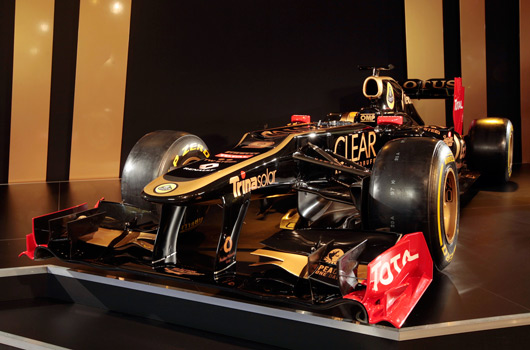
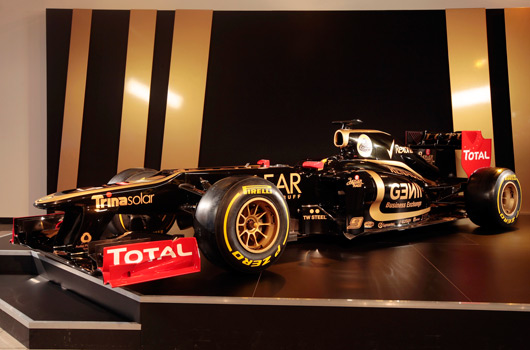
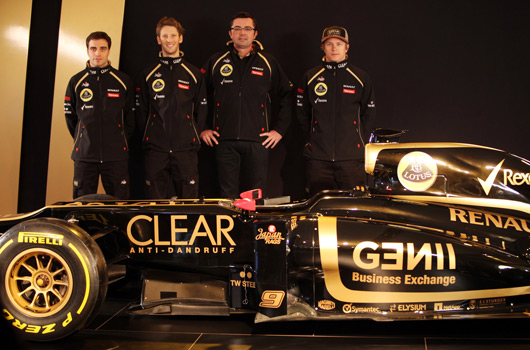
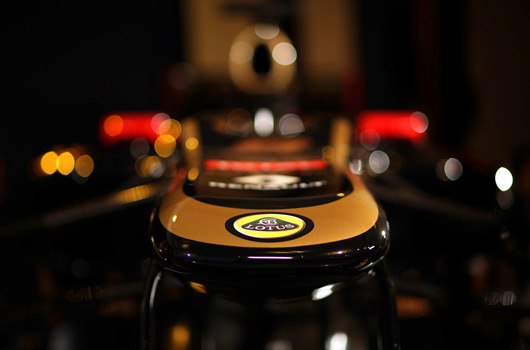
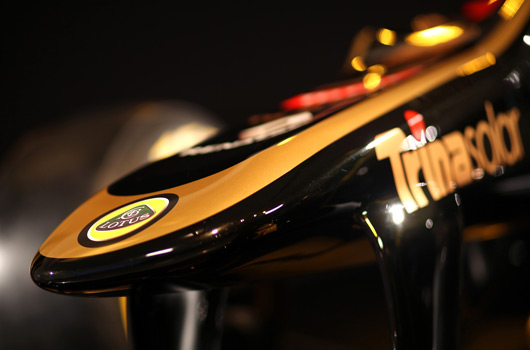
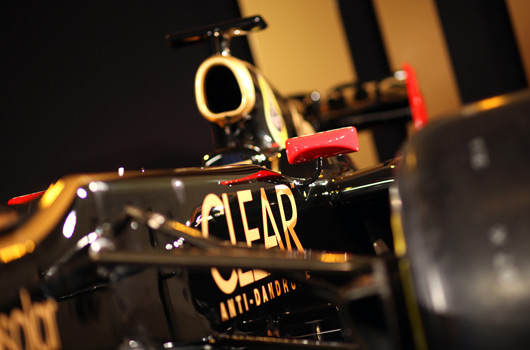
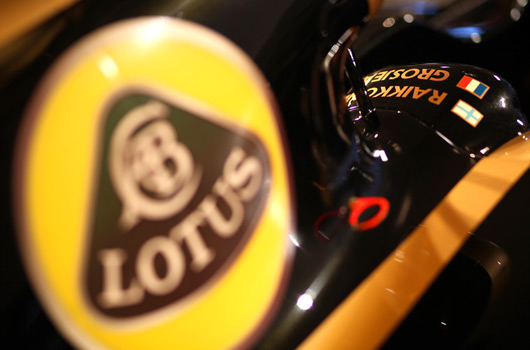
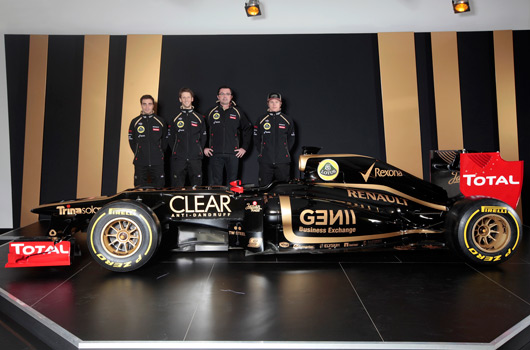
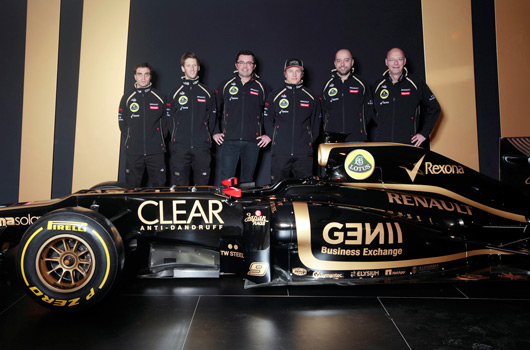
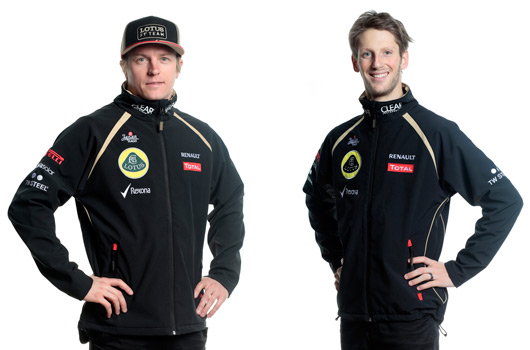
12 replies on “Lotus unveils 2012 F1 car”
That platypus nose looks good compared to the other Frankenstein efforts.
[…] of the 2012 cars across the four days, only behind Romain Grosjean, who yesterday drove the E20 to a best lap of […]
[…] Lotus E20 […]
[…] complaints that something wasn’t right in the E20-02 chassis. Lotus ran their E20-01 chassis in Jerez and performed quite well. The second car has been returned to their Enstone headquarters […]
[…] first pre-season visit to Barcelona by setting the fastest time in testing overnight. Grosjean sent the Lotus E20 around the Circuit de Catalunya in 1:25.252. That’s around one second slower than Kamui […]
[…] Lotus E20 has once again shown the F1 field a clean pair of heels with Romain Grosjean improving on […]
[…] Chassis: E20 […]
[…] ausmotive.com via Fran on […]
[…] Chassis: E20 […]
vamos lotus todavia
[…] This is one of the sadder stories from F1 in recent times. All things being equal you’d think a fit and able Kubica would have already notched up a couple of wins at the wheel of the Lotus E20. […]
[…] Here at Ausmotive HQ we were hoping to see the end of the terrible ‘platypus’ nose design from last year. But it seems as though Lotus thought the addition of some more red paint, further diluting the classic Lotus livery from the 1970s and 80s, would be enough to distract people’s attention that, really, this car looks pretty much like last year’s E20. […]